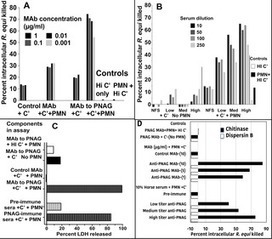Antibody to Poly-N-acetyl glucosamine provides protection against intracellular pathogens: Mechanism of action and validation in horse foals challenged with Rhodococcus equi
Author summary Development of effective vaccines for diseases such as tuberculosis, brucellosis and others caused by intracellular pathogens has proved challenging, as data exist supporting both antibody and cellular immune effectors as mediators of protection. To address this problem against an important, and representative, equine intracellular pathogen, we chose to test a vaccine candidate for the ability to protect horse foals challenged at 4 weeks of age with Rhodococcus equi. To make these foals immune, their pregnant mares were immunized with a vaccine targeting the conserved surface antigen found on many microbes, termed PNAG. Antibody in the pregnant mares was transferred to their foals and, after the foals were challenged, 91% of those born to vaccinated mares were protected against R. equi pneumonia. Meanwhile, 86% of the non-vaccinated controls developed pneumonia. We also showed antibody to PNAG could kill various bacteria that produce this antigen when residing inside of human macrophage cells, a new mechanism for antibody-mediated immunity to intracellular bacteria. These results support the development of PNAG as a vaccine for intracellular bacterial pathogens.
Antibody to Poly-N-acetyl glucosamine provides protection against intracellular pathogens: Mechanism of action and validation in horse foals challenged with Rhodococcus equi
Source: Virology News
